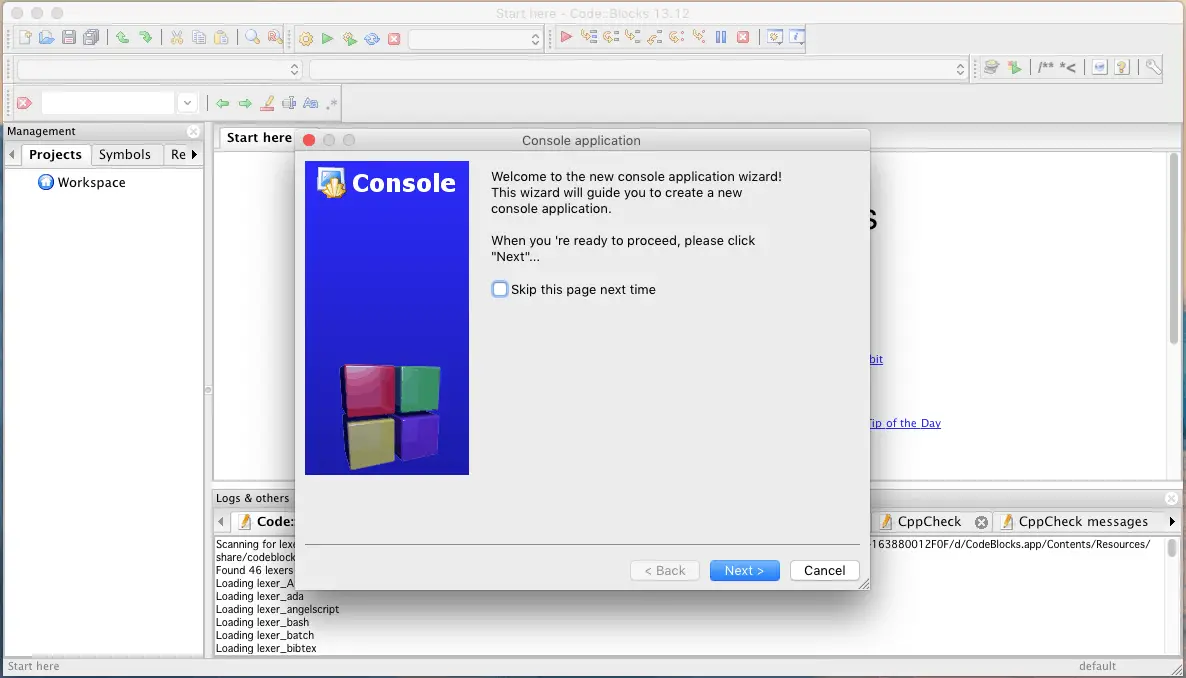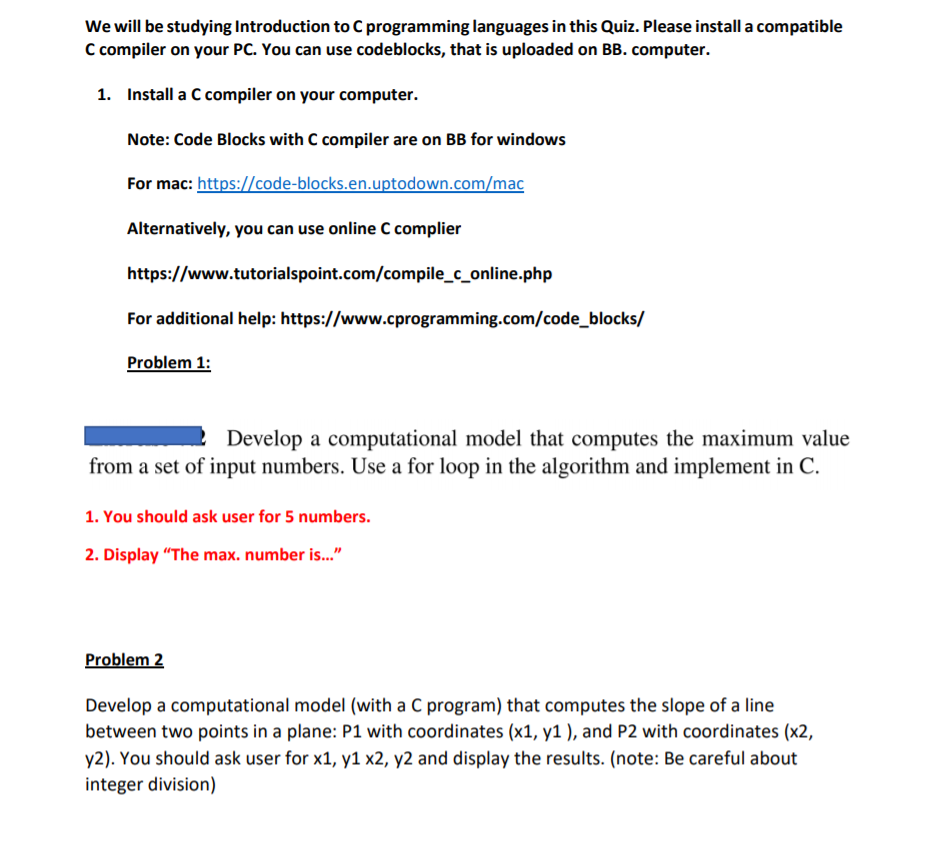This tutorial explains how to install Codeblocks on your local environment or PC with Windows, Mac, or on Linux.
- Code::Blocks for Mac – Download Free (2019 Latest Version). The open source, cross platform, free C, C and Fortran IDE. Before you download the.dmg file, here we go some fact about Code::Blocks for Mac that maybe you want to need to know.
- Code::Blocks is a free C/C and Fortran IDE built to meet the most demanding needs of its users. It is designed to be very extensible and fully configurable. Built around a plugin framework, Code::Blocks can be extended with plugins. Any kind of functionality can be added by installing/coding a plugin.
- Similar Software for Mac. Install Pd on Mac OSX; Install WireOver on Mac OSX; Install CLion on Mac OSX; Install Zipeg on Mac OSX; Install Zoom.us on Mac OSX; Install YY on Mac OSX; Install Zoho Docs on Mac OSX; Install ZeroTier One on Mac OSX; Install Zotero on Mac OSX; Install Zed on Mac OSX.
Join the DZone community and get the full member experience.
The Macintosh version of Code::Blocks for C relies on the Xcode distribution from Apple for its compiler. The installation is done in three separate parts for this reason. Installing Xcode Xcode is a free development package offered by Apple that you will need. Follow these steps to install it first: Open the Safari browser and.
Join For FreeThis tutorial explains how to install Codeblocks on your local environment or PC with Windows, Mac, or on Linux.
CodeBlocks is a cross-platform, open-source, free IDE that supports GCC, Visual C++, and Clang compilers. Codeblocks was developed in C++ using wxWidgets for Windows and Linux as the GUI toolkit. It is oriented towards C, C++, and Fortran with custom build system support.
Install CodeBlocks IDE on Windows
- Visit codeblocks.org. Click Download from the menu, then click on download the binary release.
- Go to your operating platform section (e.g., Windows XP / Vista / 7 / 8.x / 10), then download the installer with GCC Compiler, e.g., codeblocks-17.12mingw-setup.exe or Click here to download.
- Double-click to run the downloaded installer and click Next on the pop-up window. Now click on “I Agree” to accept the license agreement.
- On the new pop-up, don’t do anything, just click Next and then change the installation directory if you want (default directory recommended). Click Install.
- Wait for a minute for installation to complete. A new pop-up asks you to run Codeblocks. Click YES, and then it shows the compiler Codeblocks detected. Click OK.
- Now we have installed Codeblocks on windows.
We need to verify the Compiler and Debugger path (this step is optional).

- Go to menu options and click on Settings >> Compiler. In the selected compiler, by default, it shows GNU GCC Compiler. Now select the “Toolchain Executables” tab from the below tabs and check the Compiler’s Installation Directory is set to “
C:Program FilescodeblocksMinGW. - Similarly, for debugger path: Settings >> Debugger >> GDB/CDB debugger >> Default. In Executable, the path should be
C:Program FilescodeblocksMinGWbingdb.exeorC:MinGWbingdb.exeif you have installed MinGW compiler before installing Codeblocks.
Note: If you encountered problems running the debugger with CodeBlocks, do a clean installation. Uninstall Codeblocks and then first install MinGW and then install Codeblocks.
Thanks for reading!

Published at DZone with permission of Chand Pasha. See the original article here.
Opinions expressed by DZone contributors are their own.
Popular on DZone
If you work on a Mac OS X 10.9 Mavericks or later, you will run into the problem of Eclipse refusing to interactively debug problems that otherwise build and run fine: An attempt to start a debugging session by selecting Run
Debug from the menu will result in Eclipse complaining that an Error with command: gdb --version
has occurred.
The problem is caused by Apple switching away from GDB, the GNU debugger, to LLDB, the LLVM debugger, in their Xcode toolchain (along with the transition from GCC to Clang). Unfortunately, Eclipse is not capable of communicating with any debugger other than GDB (yet). Here is a step-by-step guide for installing and configuring GDB.
Installing GDB
As with GCC, the easiest way to install GDB is through Homebrew. In a Terminal window, run the command brew install gdb, and wait for it to complete. (As usual, it may ask for your password.)
Now, we need to code-sign the GDB executable, so it will be allowed to control other processes, as necessary for a debugger. For that, we will first create a new certificate in Keychain.
Creating a Certificate
Open the Keychain Access application (can be found in Applications/Utilities directory or through Spotlight). Select Certificate Assistant
Create a Certificate in the application menu (Keychain Access). An assistant window will appear for guiding you through the process.
Using Codeblocks On Mac
- First, you will be asked for the name and type of the certificate. You may choose the name arbitrarily, but to simplify its future use in command line, prefer names without spaces or other fancy characters, e.g.,
gdbcert. - Make sure that Identity Type is set to Self Signed Root, change Certificate Type to Code Signing, check the Let me override defaults checkbox, and click Continue. Click Continue again in the popup prompt warning about the certificate being self-signed.
- On the next page, leave Security Number to be 1, and set Validity Period to a large enough number of days to cover the duration of the class or more, say, 365. (Certificates cannot last forever; the maximum validity period is 20 years.)
- Then click Continue once again, and keep doing so to skip the next six screens until you see the one entitled Specify a Location For The Certificate. For the only property, Keychain, choose System from the drop-down list. Lastly, click Create, type in your password, if prompted, and click Done.
- Back in the main window, choose the System keychain in the sidebar on the left, and select the newly created certificate from the list. Open the context menu and select Get Info. In the information window that will appear, expand the Trust section and set the Code Signing property to Always Trust. Close this window (you may be asked for your password), and quit Keychain Access.
Signing GDB
Our new certificate is now ready to be used. In order to make it immediately available for signing, we need to restart the Taskgate access-control service. You can use Activity Monitor to do this (also found in Applications/Utilities). Open it and filter the list of processes by typing taskgated in the search field in the toolbar. (If you cannot find it, make sure the menu item View
All Processes is checked.)
Blocks Download Mac Os X
There should be exactly one process left in the list. Highlight it, then select View
Quit Process from the menu, and click Quit in the popup prompt. The Taskgate process will be terminated and, consequently, should disappear from the list. In a few seconds, it will be restarted by the system and should reappear in the list. Please wait for this to happen (it may take up to a minute or two, at worst).
Finally, in a Terminal window, run codesign -s gdbcert /usr/local/bin/gdb (if you named your certificate differently, replace gdbcert with its name here). Once again, you will be prompted for you username and password. If the command does not produce any output, then GDB is successfully signed.
Configuring Eclipse
The only thing left to do is to point Eclipse to the GDB executable. Open Eclipse
Preferences from the main menu (not to be confused with Project Preferences). In the tree of options listed in the sidebar, navigate to C/C++
Debug
GDB, and set the GDB debugger field to /usr/local/bin/gdb.

If there is no GDB section in the C/C++
Debug subtree, close the preferences window, and try to first start a debugging session for any project that you can already run without problems. You can do it by either clicking the Debug button on the toolbar, or selecting Run
Debug from the main menu. This attempt will, of course, fail with an error message about the gdb command, but it will force the said C/C++
Debug
GDB settings to appear in the preferences.
This will change the GDB executable for new projects; for all existing ones (that you are going to use debugging for), you will need to manually update their debug configurations. To do that, select Run
Debug Configurations from the menu. In the window that appears, one after another, select every project under the C++ Application section in the sidebar. For each of them, open the Debugger tab, set the GDB debugger field to the same path /usr/local/bin/gdb, and click the Apply button. After repeating this change for all listed projects, click Close.
If the above steps do not solve the issue on your machine, or you encounter a problem while following them, please do not hesitate to come to one of the upcoming common labs for help.
Codeblocks On Mac Catalina
